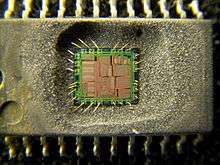Yamaha YMF262


The Yamaha YMF262, also known as the OPL3 (OPL is an acronym for FM Operator Type-L), is an FM synthesis sound chip released by Yamaha Corporation in 1988. It is an improved version of the Yamaha YM3812 (OPL2C).
Overview
The YMF262 improves upon the feature-set of the YM3812, adding the following features:[1]
- twice as many channels (18 instead of 9)
- simple stereo (hard left, center or hard right)
- 4 channel sound output
- 4 new waveforms (alternating-sine, "camel"-sine, square and logarithmic sawtooth)
- 4 oscillator mode, pairing 2 channels together to create up to six 4 oscillator FM voices
- reduced latency for host-register access (the OPL2 had much longer I/O access delays)
- subtle differences in the sine-wave lookup table and envelope generator from YM3812 (e.g. the modulator waveform on YM3812 is delayed by one sample, whereas both carrier and modulator waveforms on OPL3 are properly synchronized)[2]
YMF262 also removed support for the little-used CSM mode, featured on YM3812 and YM3526.
The YMF262's FM synthesis mode was configurable in different ways.
- Its basic mode provided 18 two-operator FM channels.
- One setting, common to the OPL line, converts 3 of the FM channels into a 5-channel percussion set.
- Another setting, introduced with this chip, causes 12 of the channels to be paired up into 6 four-operator channels. This trades in polyphony for more complex sound formation.
- The two settings can be used separately or in conjunction, resulting in four total modes:
- 18 2-operator channels
- 15 2-operator channels + 5 drum channels (drum setting on)
- 6 2-operator channels + 6 4-operator channels (4-op setting on)
- 3 2-operator channels + 6 4-operator channels + 5 drum channels (both settings on)
The YMF262 was used in many sound cards, including the popular Sound Blaster Pro 2.0, Sound Blaster 16 ASP and AWE family.
Like its predecessor, the OPL3 outputs audio in digital-I/O form, requiring an external DAC chip like the YAC512.
Variants and Derivatives
Yamaha also produced a fully compatible, low-power variant, the YMF289 OPL3-L, which targeted PCMCIA sound cards and laptop computers.
Yamaha's later PC audio controllers, including the YMF278 (OPL4), the single-chip Yamaha YMF718/719S, and the PCI YMF724/74x family, included the YMF262's FM synthesis block for backward compatibility with legacy software. See YMF7xx for more information.
Competing sound chip vendors (such as ESS, OPTi, Crystal and others) designed their own OPL3-compatible audio chips, with varying degrees of faithfulness to the original OPL3. Some manufacturers (namely Avance Logic, now Realtek) reverse-engineered the YMF262 and implemented a near-identical clone in their chips.
In 2015 an open-source RTL implementation of the OPL3 was written in SystemVerilog and adapted to an FPGA.[3]
Yamaha YMF289

The Yamaha YMF289 is a low-power version of the YMF262. It is designed for low-power applications such as laptops and PCMCIA sound cards. It was used in some Sound Blaster 16 sound cards made by Creative Technology. The YMF289B is paired with a YAC513 or YAC516 companion floating-point DAC chip.
The YMF289 is fully register-compatible with and retains the feature-set of the YMF262, with a number of differences:[4]
- Supports 5 or 3.3 volt operation.
- The registers can be read or written by the host CPU, whereas on the YMF262 they are write-only.
- 44100 Hz (44.1 kHz) output sample rate.
- A power-down mode is added.
- Somewhat smaller overall footprint, including DAC, compared to a full YMF262 implementation.
The YMF289's output is resampled to 44.1 kHz through a linear interpolator to reduce the artifacts generated from the process. Presumably, this resampling was done to ease interfacing with then-contemporary integrated sound controllers which had limited output sample rate and mixing logic, as the PCB real estate inside laptops and PCMCIA devices may be insufficient to implement a more complex mixer and/or filtering circuit. However, the linear interpolator does not remove all artifacts, and the pitch of the output is subtly lower than the YMF262's as well.
ESS ESFM

ESS Technology's in-house developed derivative, termed ESFM, is an enhanced, 20-voice, 72-operator, OPL3-compatible clone incorporating two operating modes, a Native mode and a Legacy mode, which controls its feature-set and behavior. In Native mode, ESFM allows more than six 4-operator FM voices to be mapped, potentially allowing for a significant increase in the complexity of tones generated. The drivers for Windows 9x incorporate their own custom instrument patches which make use of this extended mode. Conversely, Legacy mode provides full backward-compatibility with Yamaha's YMF262.[5] ESFM's output in this mode is moderately faithful to the YMF262 overall, but some tones are rendered quite differently, resulting in unique distortions in the sound and music of some games.
ESFM is available in ESS sound chips starting with the ISA-based ES1688 AudioDrive, up to the PCI-based ES1938 Solo-1, whereas earlier chips required an external FM synthesizer chip (typically a Yamaha YMF262). ESS's Maestro series of PCI-based sound chips rely on a software implementation of FM synthesis that lacks ESFM's special features.
References
External links
- MIDIbox FM, a YMF262-based DIY synthesizer
- AdlibTracker.net Adlib Tracker II (YMF262-Tracker)
- An YMF262 emulator with an online player for OPL3 music.
- OPLx decapsulated (a reverse engineering report)
- OPL3_FPGA GitHub Reverse engineered OPL3 in an FPGA
- Analysis of the OPL3 math